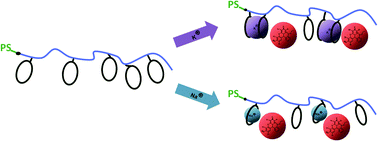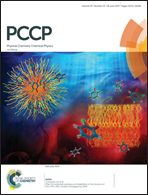Thermodynamic analysis of alkali metal complex formation of polymer-bonded crown ether†
Abstract
The complex formation of two crown ethers with colored alkali metal salts was investigated by UV/Vis spectroscopy. Complexation was accomplished with free benzo-15-crown-5 (B15C5) and 15-crown-5 bonded to a diblock copolymer (Poly15C5). The diblock copolymer was synthesized by two controlled polymerization techniques and copper(I)-catalyzed azide–alkyne cycloaddition. Depending on the inserted cation, 1 : 1- or 1 : 2-complexes are formed. A significant difference of the stability constants was determined by concentration dependence solvent extraction with sodium or potassium salt. For Poly15C5 the stability constants increase for both salts compared to the stability constants of B15C5, which suggests a more effective complexation. Evaluation of the thermodynamics (ΔH, ΔS, ΔG) of cation complexation was achieved by temperature dependence phase extraction on the basis of established thermodynamic equations. Remarkably, in all cases the entropic gain seems to be the major propulsion facilitating the complexation between alkali metal salts and crown ethers. Indeed, by using Poly15C5 a more pronounced dependency of enthalpy and entropy on the complex formation is calculated.



 Please wait while we load your content...
Please wait while we load your content...